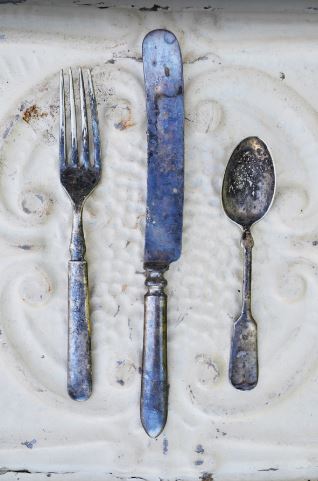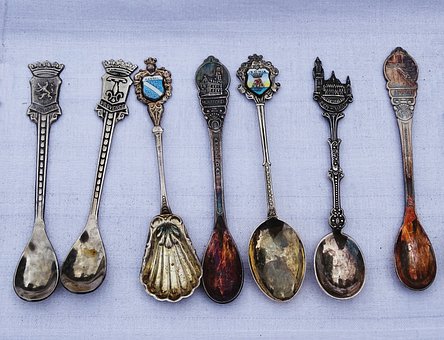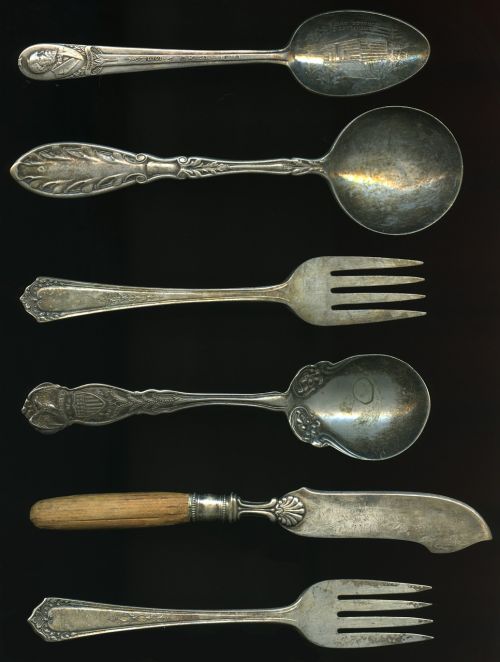The Surprising History of Forks, Spoons and Knives
I’m back with some more quirky history from things I learned during an episode of my favorite food podcast, Gastropod. This was their episode called “The Golden Spoon”, where they shared stories about the history behind the cutlery we use every day.

I’ve never really given too much thought about the cutlery we use and that it’s history is of too much interest or importance, but that was very naïve. The utensils we use and what they’re made of can make things taste different, and have even historically changed the shape of the human mouth. Each utensil—the fork, spoon, and knife—all have their own unique history with a lot of interesting facts about how they came to be. So let’s delve into it a bit, shall we?
The Knife. We are going to go in order of when people started using the different utensils. The idea of carrying food from the hands to the mouth by a utensil wasn’t used for a long time with humans. Initially, they simply used seashells as a spoon like tool to shovel food to their mouth. Or even fashioned a bowl from wood or by using a really large shell.The knife was the first utensil that people actually started carrying around with them and using for food. Each person used to carry around their own personal knife. Its actual purpose was that it could be used as a weapon, if need be, but was as personal to each person as your own toothbrush. No one would share a knife with anyone else--that was just gross! The knife was obviously there to cut things like meat and then they’d eat the rest of the meal with their fingers.
Historians believe the shape of the human mouth changed with the sudden use of cutting food into smaller bites of the knife, rather than ripping it off with their teeth. The overbite and the way our teeth now sit--similar to the lid on a box, rather than all of the teeth just stacked on top of each other like our molars are-- has only been around for a couple hundred years. They believe this to be true since people of Asian cultures formed this type of mouth shape hundreds of years before as they started also cutting food into smaller bites and using chopsticks instead of just their teeth.

The Spoon. The spoon is the next utensil to come along and it definitely has its own unique history too. The first type of spoon used was forming a spoon shape with wood. One particular man from Scotland made many different Proto types of spoons that had different uses and shapes--more shallow and wide, very deep and narrow, ect. One of the proto types he had was the more shallow spoon that we all use almost exclusively for everything today. He believed this to be one of the most unsatisfactory shapes of all his spoon shapes. So that is kind of ironic that it is the one we almost always use nowadays.
When spoons first started being used a lot, people became absolutely obsessed and had a spoon use for everything. They really loved mustard back in the 15th century and had a little spoon specifically for mustard.

The Fork. Apparently the fork was a pretty wild invention and when it first came out, people were very alarmed at the thought of piercing food with a pointy end and putting that metal in the mouth along with the food. The fork started out with just one prong and The Italians were the first to really get on board with the idea, probably because of their love of pasta. With the one prong, they found it especially useful for their foods like ravioli and lasagna, but they also used it to wind around their long noodles such as spaghetti and linguine to make it easier. Keep in mind that the pasta dishes back then in Italy were different than they are today. They were not saucy like the spaghetti we are familiar with now. It usually was simply noodles and possibly a bit of cheese grated on top. So this wouldn’t have been as obnoxious to eat with a one prong fork as you might think.
France and England were a little later to get on board with the idea of the fork, but eventually they adopted it as well. One prong forks turns into two prongs. And as they used two prong forks they figured three would be better, and then sometimes even four.
Eventually, just like with the spoon, they went really crazy for forks and had forks for every type of food and occasion--different forks specifically for olives, sardines, salads, terrapins, and even a fork made just for ice cream. Yes, you read that right. A fork for ice cream! As you can imagine, this was giving people major anxiety of knowing which fork is for what and when to use it. You know how British people are with their rules of cutlery and etiquette :) Nowadays there are certainly different forks if you are sitting down to a fancy meal, even in America, but not as many as there used to be, thank heavens!
Well, there you have it--a brief little history of our most common used utensils in this 21st century. I found this history and these stories to be so fascinating! It’s not often that I sit and think about something so simple as my fork and how it came to be. It’s kind of nice to take the time to think about it and be grateful for it.
Next week I want to tell you a little bit more about the metals that were and are used for cutlery and how it affects the taste of the foods we eat. It is good stuff. Do you have any vintage heirloom cutlery that has been passed down from previous generations? Do you use it for fancy holidays or meals? Maybe there is even a weird shaped spoon or fork that you are not quite sure what it is mean for. Please share your thoughts in the comments below.
I’ve never really given too much thought about the cutlery we use and that it’s history is of too much interest or importance, but that was very naïve. The utensils we use and what they’re made of can make things taste different, and have even historically changed the shape of the human mouth. Each utensil—the fork, spoon, and knife—all have their own unique history with a lot of interesting facts about how they came to be. So let’s delve into it a bit, shall we?
The Knife. We are going to go in order of when people started using the different utensils. The idea of carrying food from the hands to the mouth by a utensil wasn’t used for a long time with humans. Initially, they simply used seashells as a spoon like tool to shovel food to their mouth. Or even fashioned a bowl from wood or by using a really large shell.The knife was the first utensil that people actually started carrying around with them and using for food. Each person used to carry around their own personal knife. Its actual purpose was that it could be used as a weapon, if need be, but was as personal to each person as your own toothbrush. No one would share a knife with anyone else--that was just gross! The knife was obviously there to cut things like meat and then they’d eat the rest of the meal with their fingers.
Historians believe the shape of the human mouth changed with the sudden use of cutting food into smaller bites of the knife, rather than ripping it off with their teeth. The overbite and the way our teeth now sit--similar to the lid on a box, rather than all of the teeth just stacked on top of each other like our molars are-- has only been around for a couple hundred years. They believe this to be true since people of Asian cultures formed this type of mouth shape hundreds of years before as they started also cutting food into smaller bites and using chopsticks instead of just their teeth.

The Spoon. The spoon is the next utensil to come along and it definitely has its own unique history too. The first type of spoon used was forming a spoon shape with wood. One particular man from Scotland made many different Proto types of spoons that had different uses and shapes--more shallow and wide, very deep and narrow, ect. One of the proto types he had was the more shallow spoon that we all use almost exclusively for everything today. He believed this to be one of the most unsatisfactory shapes of all his spoon shapes. So that is kind of ironic that it is the one we almost always use nowadays.
When spoons first started being used a lot, people became absolutely obsessed and had a spoon use for everything. They really loved mustard back in the 15th century and had a little spoon specifically for mustard.

The Fork. Apparently the fork was a pretty wild invention and when it first came out, people were very alarmed at the thought of piercing food with a pointy end and putting that metal in the mouth along with the food. The fork started out with just one prong and The Italians were the first to really get on board with the idea, probably because of their love of pasta. With the one prong, they found it especially useful for their foods like ravioli and lasagna, but they also used it to wind around their long noodles such as spaghetti and linguine to make it easier. Keep in mind that the pasta dishes back then in Italy were different than they are today. They were not saucy like the spaghetti we are familiar with now. It usually was simply noodles and possibly a bit of cheese grated on top. So this wouldn’t have been as obnoxious to eat with a one prong fork as you might think.
France and England were a little later to get on board with the idea of the fork, but eventually they adopted it as well. One prong forks turns into two prongs. And as they used two prong forks they figured three would be better, and then sometimes even four.
Eventually, just like with the spoon, they went really crazy for forks and had forks for every type of food and occasion--different forks specifically for olives, sardines, salads, terrapins, and even a fork made just for ice cream. Yes, you read that right. A fork for ice cream! As you can imagine, this was giving people major anxiety of knowing which fork is for what and when to use it. You know how British people are with their rules of cutlery and etiquette :) Nowadays there are certainly different forks if you are sitting down to a fancy meal, even in America, but not as many as there used to be, thank heavens!
Well, there you have it--a brief little history of our most common used utensils in this 21st century. I found this history and these stories to be so fascinating! It’s not often that I sit and think about something so simple as my fork and how it came to be. It’s kind of nice to take the time to think about it and be grateful for it.
Next week I want to tell you a little bit more about the metals that were and are used for cutlery and how it affects the taste of the foods we eat. It is good stuff. Do you have any vintage heirloom cutlery that has been passed down from previous generations? Do you use it for fancy holidays or meals? Maybe there is even a weird shaped spoon or fork that you are not quite sure what it is mean for. Please share your thoughts in the comments below.
Sources:
- www.pxhere.com
- www.pixabay.com
- www.gastropod.com
- Book: Consider the fork, by Bee Wilson
 Mary Richardson
Mary Richardson
Weekly Newsletter Contributor since 2014
Email the author! mary@dvo.com
